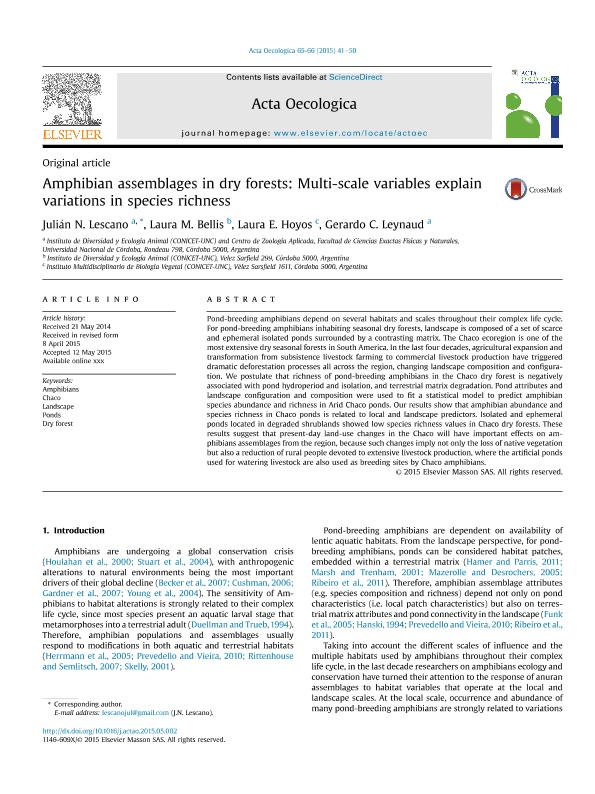Artículo
Amphibian assemblages in dry forests: Multi-scale variables explain variations in species richness
Fecha de publicación:
05/2015
Editorial:
Elsevier
Revista:
Acta Oecologica
ISSN:
1146-609X
Idioma:
Inglés
Tipo de recurso:
Artículo publicado
Clasificación temática:
Resumen
Pond-breeding amphibians depend on several habitats and scales throughout their complex life cycle. For pond-breeding amphibians inhabiting seasonal dry forests, landscape is composed of a set of scarce and ephemeral isolated ponds surrounded by a contrasting matrix. The Chaco ecoregion is one of the most Extensive dry seasonal forests in South America. In the last four decades, agricultural expansion and transformation from subsistence livestock farming to commercial livestock production have triggered dramatic deforestation processes all across the region, changing landscape composition and configuration. We postulate that richness of pond-breeding amphibians in the Chaco dry forest is negatively associated with pond hydroperiod and isolation, and terrestrial matrix degradation. Pond attributes and landscape configuration and composition were used to fit a statistical model to predict amphibian species abundance and richness in Arid Chaco ponds. Our results show that amphibian abundance and species richness in Chaco ponds is related to local and landscape predictors. Isolated and ephemeral ponds located in degraded shrublands showed low species richness values in Chaco dry forests. These results suggest that present-day land-use changes in the Chaco will have important effects on amphibians assemblages from the region, because such changes imply not only the loss of native vegetation but also a reduction of rural people devoted to extensive livestock production, where the artificial ponds used for watering livestock are also used as breeding sites by Chaco amphibians.
Palabras clave:
Amphibians
,
Chaco
,
Landscape
,
Dry Forest
Archivos asociados
Licencia
Identificadores
Colecciones
Articulos(IDEA)
Articulos de INSTITUTO DE DIVERSIDAD Y ECOLOGIA ANIMAL
Articulos de INSTITUTO DE DIVERSIDAD Y ECOLOGIA ANIMAL
Citación
Lescano, Julián Norberto; Bellis, Laura Marisa; Hoyos, Laura Emilia; Leynaud, Gerardo Cristhian; Amphibian assemblages in dry forests: Multi-scale variables explain variations in species richness; Elsevier; Acta Oecologica; 65-66; 5-2015; 41-50
Compartir
Altmétricas




